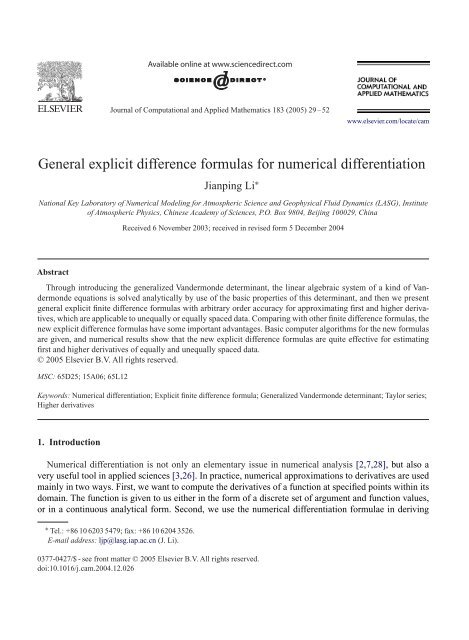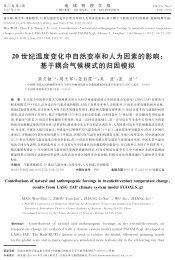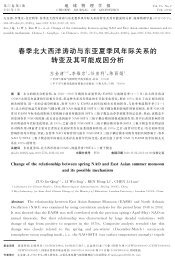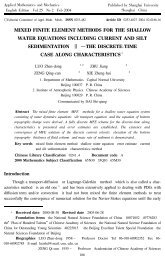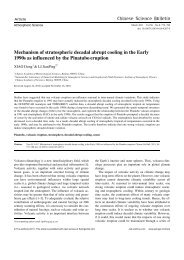General explicit difference formulas for numerical differentiation
General explicit difference formulas for numerical differentiation
General explicit difference formulas for numerical differentiation
You also want an ePaper? Increase the reach of your titles
YUMPU automatically turns print PDFs into web optimized ePapers that Google loves.
Journal of Computational and Applied Mathematics 183 (2005) 29–52<br />
www.elsevier.com/locate/cam<br />
<strong>General</strong> <strong>explicit</strong> <strong>difference</strong> <strong><strong>for</strong>mulas</strong> <strong>for</strong> <strong>numerical</strong> <strong>differentiation</strong><br />
Jianping Li ∗<br />
National Key Laboratory of Numerical Modeling <strong>for</strong> Atmospheric Science and Geophysical Fluid Dynamics (LASG), Institute<br />
of Atmospheric Physics, Chinese Academy of Sciences, P.O. Box 9804, Beijing 100029, China<br />
Received 6 November 2003; received in revised <strong>for</strong>m 5 December 2004<br />
Abstract<br />
Through introducing the generalized Vandermonde determinant, the linear algebraic system of a kind of Vandermonde<br />
equations is solved analytically by use of the basic properties of this determinant, and then we present<br />
general <strong>explicit</strong> finite <strong>difference</strong> <strong><strong>for</strong>mulas</strong> with arbitrary order accuracy <strong>for</strong> approximating first and higher derivatives,<br />
which are applicable to unequally or equally spaced data.Comparing with other finite <strong>difference</strong> <strong><strong>for</strong>mulas</strong>, the<br />
new <strong>explicit</strong> <strong>difference</strong> <strong><strong>for</strong>mulas</strong> have some important advantages.Basic computer algorithms <strong>for</strong> the new <strong><strong>for</strong>mulas</strong><br />
are given, and <strong>numerical</strong> results show that the new <strong>explicit</strong> <strong>difference</strong> <strong><strong>for</strong>mulas</strong> are quite effective <strong>for</strong> estimating<br />
first and higher derivatives of equally and unequally spaced data.<br />
© 2005 Elsevier B.V. All rights reserved.<br />
MSC: 65D25; 15A06; 65L12<br />
Keywords: Numerical <strong>differentiation</strong>; Explicit finite <strong>difference</strong> <strong>for</strong>mula; <strong>General</strong>ized Vandermonde determinant; Taylor series;<br />
Higher derivatives<br />
1. Introduction<br />
Numerical <strong>differentiation</strong> is not only an elementary issue in <strong>numerical</strong> analysis [2,7,28], but also a<br />
very useful tool in applied sciences [3,26].In practice, <strong>numerical</strong> approximations to derivatives are used<br />
mainly in two ways.First, we want to compute the derivatives of a function at specified points within its<br />
domain.The function is given to us either in the <strong>for</strong>m of a discrete set of argument and function values,<br />
or in a continuous analytical <strong>for</strong>m.Second, we use the <strong>numerical</strong> <strong>differentiation</strong> <strong>for</strong>mulae in deriving<br />
∗ Tel.: +86 10 6203 5479; fax: +86 10 6204 3526.<br />
E-mail address: ljp@lasg.iap.ac.cn (J.Li).<br />
0377-0427/$ - see front matter © 2005 Elsevier B.V. All rights reserved.<br />
doi:10.1016/j.cam.2004.12.026
30 J. Li / Journal of Computational and Applied Mathematics 183 (2005) 29–52<br />
<strong>numerical</strong> methods <strong>for</strong> solving ordinary differential equations (ODEs) and partial differential equations<br />
(PDEs).<br />
A number of different techniques have been developed to construct useful <strong>difference</strong> <strong><strong>for</strong>mulas</strong> <strong>for</strong> <strong>numerical</strong><br />
derivatives.Most approaches of them fall into five categories: finite <strong>difference</strong> type [2–4,7,17–22,<br />
25,26,28], polynomial interpolation type [2,3,7–9,11,27,28], operator type [7,33], lozenge diagrams [10],<br />
and undetermined coefficients [10,14].Other <strong>numerical</strong> <strong>differentiation</strong> methods, which do not aim at developing<br />
<strong>difference</strong> <strong><strong>for</strong>mulas</strong> of derivatives but evaluating <strong>numerical</strong> derivatives by use of data or given<br />
analytical <strong>for</strong>ms of functions, include: Richardson extrapolation [2,3,7,16,25,28], spline <strong>numerical</strong> <strong>differentiation</strong><br />
[36,37], regularization method [1,6,23,35], and automatic <strong>differentiation</strong> (AD) [5,12,13,30].<br />
The AD is an accurate <strong>differentiation</strong> technique based on the mechanical application of the chain rule<br />
to obtain the derivatives of a function expressed by a computer program, but it cannot be applied to the<br />
cases in which analytical expressions of functions are unknown.However, it is very familiar in practice<br />
that the derivatives of a function whose values are only obtained empirically at a discrete set of points<br />
need to be evaluated.The regularization method on <strong>numerical</strong> <strong>differentiation</strong> is effective and stable <strong>for</strong><br />
estimating the first derivative of a function with non-exact data.This kind of method is divided mainly<br />
into three sorts: parameter regularization [31,32], mollification regularization [15,29,35] and variational<br />
regularization [24,34].However, some of the regularization methods strongly depend on a regularization<br />
parameter whose optimal value choice is a nontrivial task.Some of the methods are limited to cases in<br />
which the spectrum of the data shows a clear division between the signal of the correct function and the<br />
noise, and some of them depend on solving a boundary value problem of second order differential equation<br />
whose <strong>numerical</strong> solutions themselves involve <strong>difference</strong> methods.It is difficult not only to improve the<br />
methods mentioned above so that they are approximations of higher order to derivatives, but also to use<br />
them directly to find higher derivatives.The dependence on evenly data is also another disadvantage.An<br />
alternative approach <strong>for</strong> evaluating derivatives is to use the Richardson extrapolation [2,3,7,16,25,28].<br />
The technique, however, is actually equivalent to fitting a higher-order polynomial through the data and<br />
then computing the derivatives by centered <strong>difference</strong>s [3].Moreover, <strong>for</strong> the Richardson extrapolation,<br />
the data have to be evenly spaced and generated <strong>for</strong> successively halved intervals.Evidently, it is not<br />
applicable to the case of non-uni<strong>for</strong>m data.A common characteristic of these methods stated above is<br />
that they cannot generally provide <strong>explicit</strong> <strong>difference</strong> <strong><strong>for</strong>mulas</strong> of derivatives <strong>for</strong> designing <strong>difference</strong><br />
schemes of both ODEs and PDEs.<br />
Numerical <strong>differentiation</strong> <strong><strong>for</strong>mulas</strong> based on interpolating polynomials (e.g., Lagrangian, Newton,<br />
Chebyshev, Hermite, Guass, Bessel, Sterling interpolating polynomials, and etc.) may be found in many<br />
literatures [2,3,7–9,11,27,28].The advantages of the methods are that they do not require that the data<br />
be equispaced, and some specific <strong>difference</strong> <strong><strong>for</strong>mulas</strong> deduced from the methods can be used to estimate<br />
the derivative anywhere within the range prescribed by the known points.Un<strong>for</strong>tunately, the methods are<br />
generally implicit.Take Lagrange interpolating polynomial as an example, by using the polynomial may<br />
generate general derivate approximation <strong><strong>for</strong>mulas</strong> as follows:<br />
f (m) (x i ) =<br />
n∑<br />
k=0<br />
L (m)<br />
k<br />
(x i )f (x k ) + R(x i ), i = 0, 1,...,n, (1.1)<br />
where L k (x) denotes the kth Lagrange polynomial <strong>for</strong> the function f at x 0 ,x 1 ,...,x n in some interval I,<br />
f ∈ C n+1 (I), and R(x) is the remainder term Eq.(1.1) is called an (n + 1)-point <strong>for</strong>mula to approximate<br />
f (m) (x i ).In general, it cannot be directly used to calculate the derivatives due to its dependence on L (m)<br />
k<br />
(x)
J. Li / Journal of Computational and Applied Mathematics 183 (2005) 29–52 31<br />
which is a very complex polynomial and depends on lower derivatives.Besides, it is also complicated<br />
to derive higher-order finite <strong>difference</strong> <strong><strong>for</strong>mulas</strong> by means of the method.By using operators [7,33] and<br />
by using lozenge diagrams [10] are other two useful and simple approaches to find <strong>numerical</strong> <strong>differentiation</strong><br />
<strong><strong>for</strong>mulas</strong>.In fact, all the <strong><strong>for</strong>mulas</strong> constructed by interpolating polynomials can be generated by<br />
applying operators or lozenge diagrams.However, all of these <strong><strong>for</strong>mulas</strong> use <strong>difference</strong> tables constructed<br />
from sampling data and recursive procedures by expanding the higher <strong>difference</strong>s step-by-step to lower<br />
<strong>difference</strong>s.<br />
Another alternative way <strong>for</strong> developing <strong>difference</strong> <strong><strong>for</strong>mulas</strong> is the method of undetermined coefficients,<br />
which solves n linear algebraic equations derived from certain polynomial or Taylor expansions, by<br />
imposing n necessary conditions on it [10,14].The calculation complexity of the determination of the<br />
coefficients by solving n linear equations is drastically increased while the order of the approximation<br />
increases.Moreover, a new system of equations needs to be re-solved to obtain all coefficients if the order<br />
of the approximation is changed.There<strong>for</strong>e, the method is limited to lower orders due to its complexity<br />
in calculation.However, direct use of the method will become wide if the general algebraic solutions of<br />
the linear equations on the coefficients can be theoretically found.<br />
Based on Taylor series, recently, Khan et al. [17–21] have presented the <strong>explicit</strong> <strong>for</strong>ward, backward<br />
and central <strong>difference</strong> <strong><strong>for</strong>mulas</strong> of finite <strong>difference</strong> approximations with arbitrary orders <strong>for</strong> first derivative,<br />
and the central <strong>difference</strong> approximations <strong>for</strong> higher derivates.In essential, it can be found from<br />
the mathematical proofs of their <strong>explicit</strong> <strong><strong>for</strong>mulas</strong> <strong>for</strong> the coefficients of finite <strong>difference</strong> approximations<br />
of first derivatives [22] that the <strong>explicit</strong> <strong><strong>for</strong>mulas</strong> were original from the undetermined coefficients by<br />
solving a special kind of linear equations.Most advantages of the <strong>explicit</strong> <strong>difference</strong> <strong><strong>for</strong>mulas</strong> are their<br />
convenience in calculations <strong>for</strong> <strong>numerical</strong> approximations of arbitrary order to derivatives and their direct<br />
use <strong>for</strong> solution of ODEs and PDEs.The applicability of these <strong>explicit</strong> <strong><strong>for</strong>mulas</strong>, however, appears to<br />
be limited to case in which the data had to be equispaced.In contrast, data from experiments or fields<br />
studies are often collected at unequal intervals, and such in<strong>for</strong>mation cannot be analyzed with the <strong>explicit</strong><br />
<strong><strong>for</strong>mulas</strong> mentioned above to this point.Thus, <strong>explicit</strong> techniques to handle nonequispaced data need<br />
to be developed.Besides, the coefficients of <strong>explicit</strong> central <strong>difference</strong> <strong><strong>for</strong>mulas</strong> <strong>for</strong> higher derivatives<br />
with evenly spaced data were only given in [17,21] based on <strong>numerical</strong> results, but any mathematical<br />
proof was not shown.Obviously, it is also worth studying <strong>for</strong> <strong>explicit</strong> <strong>for</strong>ward and backward <strong>difference</strong><br />
<strong><strong>for</strong>mulas</strong> <strong>for</strong> higher derivatives except that the <strong>explicit</strong> central <strong>difference</strong> <strong><strong>for</strong>mulas</strong> <strong>for</strong> higher derivatives<br />
in [17,21] should be proved.Moreover, the <strong>explicit</strong> <strong>for</strong>ward, backward and central <strong>difference</strong> <strong><strong>for</strong>mulas</strong><br />
do not give the whole circumstance.For example, if there are an eight given values of a function f at<br />
points x 0
32 J. Li / Journal of Computational and Applied Mathematics 183 (2005) 29–52<br />
in Section 4.In Section 5, the new <strong>explicit</strong> <strong><strong>for</strong>mulas</strong> are compared with other finite <strong>difference</strong> <strong><strong>for</strong>mulas</strong>.<br />
Section 6 shows a discussion of <strong>numerical</strong> results with details of our implementation, combining with<br />
basic computer algorithms of the new <strong><strong>for</strong>mulas</strong> of equally and unequally spaced data <strong>for</strong> <strong>difference</strong><br />
approximations of any order to first and higher derivatives of a function whose values are known only at<br />
a discrete set of points.Section 7 is devoted to a brief conclusion.<br />
2. Main results<br />
Suppose that x 1 ,x 2 ,...,x n are n distinct real numbers, let<br />
⎧<br />
a n (0) = a 0 (x 1 ,x 2 ,...,x n ) = x 1 x 2 ···x n ,<br />
a n (1) = a 1 (x 1 ,x 2 ,...,x n ) = x 1 x 2 ···x n−1 + x 1 x 2 ···x n−2 x n +···+x 1 x 3 ···x n + x 2 x 3 ···x n ,<br />
⎪⎨ a n (2) = a 2 (x 1 ,x 2 ,...,x n ) = x 1 x 2 ···x n−2 +···+x 3 x 4 ···x n ,<br />
···<br />
(2.1)<br />
a n (n−2) = a n−2 (x 1 ,x 2 ,...,x n ) = x 1 x 2 + x 1 x 3 +···+x n−1 x n ,<br />
a n (n−1) = a n−1 (x 1 ,x 2 ,...,x n ) = x 1 + x 2 +···+x n ,<br />
⎪⎩<br />
a n (n) = a n (x 1 ,x 2 ,...,x n ) = 1.<br />
And let Δ ij = x j − x i , writing the first divided <strong>difference</strong> of the function f with respect to x i and x j as<br />
D(x i ,x j ) = f(x j ) − f(x i )<br />
= f(x j ) − f(x i )<br />
x j − x i Δ , (2.2)<br />
ij<br />
where i ̸= j.<br />
Theorem 2.1. If x 0
J. Li / Journal of Computational and Applied Mathematics 183 (2005) 29–52 33<br />
and the remainder term<br />
R 1 (x 0 ) = f ′′ (ξ 0 )<br />
2<br />
(x 0 − x 1 ) and R 1 (x 1 ) = f ′′ (ξ 1 )<br />
(x 1 − x 0 ), <strong>for</strong> n = 1, (2.6)<br />
2<br />
R n (x i ) =<br />
1<br />
(n + 1)!<br />
n∏<br />
k=0,k̸=i<br />
(x i − x k )<br />
n∑<br />
j=0,j̸=i<br />
f (n+1) (ξ j )(x i − x j ) n−1<br />
∏ , <strong>for</strong> n>1, (2.7)<br />
nk=0,k̸=i,k̸=j (x k − x j )<br />
where ξ j depends on x j and x i .<br />
Remark 2.1. The sum of the weighing coefficients c n,i,j <strong>for</strong> any reference point x i is one, i.e.<br />
n∑<br />
j=0,j̸=i<br />
c n,i,j = 1, i = 0, 1,...,n, and n1. (2.8)<br />
This property of the <strong>differentiation</strong> approximation (2.3) guarantees that the first derivative of a linear<br />
function is a constant.In fact, <strong>for</strong> n>1 and any real number x one has a more general <strong>for</strong>mula as follows:<br />
n∑<br />
n∏<br />
j=1 k=1,k̸=j<br />
(x k − x)<br />
= 1. (2.9)<br />
(x k − x j )<br />
Remark 2.2. For n>1 the coefficients of f (n+1) (ξ j )(j= 0, 1,...,n) in (2.7) satisfy the following<br />
relation:<br />
n∑<br />
j=0,j̸=i<br />
(x i − x j ) n−1<br />
∏ = 1, i = 0, 1,...,n. (2.10)<br />
nk=0,k̸=i,k̸=j (x k − x j )<br />
For n>1 and any real number x, in fact, one can write<br />
n∑<br />
n∏<br />
j=1 k=1,k̸=j<br />
(x − x j )<br />
= 1. (2.11)<br />
(x k − x j )<br />
Corollary 2.1. If x 0 ,x 1 ,...,x n are (n+1) distinct numbers in the interval [a,b], they are equally spaced<br />
notes, i.e.,<br />
x i = x 0 + ih (i = 0, 1,...,n) <strong>for</strong> some h ̸= 0<br />
and f is a function whose values are given at these notes and f ∈ C n+1 [a,b], then <strong>for</strong> any one<br />
x i (i = 0, 1,...,n) one can use the linear combination of f(x j )(j= 0, 1,...,n) to construct an<br />
(n + 1)-point <strong>for</strong>mula to approximate f ′ (x i ), i.e.<br />
f ′ (x i ) = 1 h<br />
n∑<br />
d n+1,i,j f(x j ) + O n,i (h n ), (2.12)<br />
j=0
34 J. Li / Journal of Computational and Applied Mathematics 183 (2005) 29–52<br />
where the coefficients<br />
d n+1,i,j = (−1)i−j+1 i!(n − i)!<br />
,<br />
j − i j!(n − j)!<br />
i,j = 0, 1,...,n and j ̸= i, (2.13)<br />
n∑<br />
d n+1,i,i =− d n+1,i,j (2.14)<br />
j=0,j̸=i<br />
and the remainder term<br />
O n,i (h n ) = (−1)n−i i!(n − i)!h n<br />
(n + 1)!<br />
where ξ j depends on x j and x i .<br />
n∑<br />
j=0,j̸=i<br />
f (n+1) (ξ j )(i − j) n<br />
(−1) j , (2.15)<br />
j!(n − j)!<br />
Remark 2.3. It can been seen from (2.13) and (2.14) that the sum of the weighing coefficients d n+1,i,j<br />
<strong>for</strong> any given i(i=0, 1,...,n), ∑ n<br />
j=0 d n+1,i,j =0, to ensure that the slope of a constant function is zero.<br />
Moreover, ∑ n<br />
j=0 (j − i)d n+1,i,j = 1 guarantees that the first derivative of a linear function is a constant.<br />
Remark 2.4. The coefficients d n+1,i,j are anti-symmetric, i.e.<br />
d n+1,i,j =−d n+1,n−i,n−j , (2.16)<br />
where n1, j = 0, 1,...,n, i = 0, 1,...,[n/2], here the symbol [x] denotes the greatest integer not<br />
greater than x.Especially, when n=2l, where l is a natural number, d 2l+1,l,l =0, d 2l+1,l,j =−d 2l+1,l,l−j ,<br />
j = 0, 1,...,l − 1.In this case, one can use the function values at n points (n is an even number) to<br />
construct an n order <strong>numerical</strong> <strong>differentiation</strong> of the first derivative f ′ (x l ) at the middle point x l .As<br />
known, at this time the <strong>difference</strong> approximation is called the central <strong>differentiation</strong>.<br />
Remark 2.5. In practice, to reduce computational burden, <strong>for</strong> large number n, one can use the following<br />
recursive procedure to calculate the coefficients d n+1,i,j :<br />
A 0 = 0!n!, (2.17)<br />
i<br />
A i = A i−1 ,<br />
(n − i + 1)<br />
i = 1,...,n, (2.18)<br />
d n+1,i,j = (−1)i−j+1 A i<br />
,<br />
j − i A j<br />
i = 0, 1,...,[n/2], j= 0, 1,...,n, and j ̸= i (2.19)<br />
and d n+1,i,i is calculated by (2.14), and the other coefficients d n+1,i,j (i=[n/2]+1,...,n, j =0, 1,...,n,<br />
j ̸= i) can be obtained easily by use of the <strong>for</strong>mula (2.16).<br />
Remark 2.6. For n>1 and any given i(i=0, 1,...,n), the coefficients of f (n+1) (ξ j )(j=0, 1,...,n)<br />
in the remainder term (2.15) satisfy<br />
n∑ (i − j) n<br />
(−1) j = 1. (2.20)<br />
j!(n − j)!<br />
j=0,j̸=i
J. Li / Journal of Computational and Applied Mathematics 183 (2005) 29–52 35<br />
Theorem 2.2. If x 0 ,x 1 ,...,x n are (n + 1) distinct numbers in the interval [a,b] and f is a function<br />
whose values are given at these numbers and f ∈ C n+1 [a,b], then <strong>for</strong> any one x i (i = 0, 1,...,n)one<br />
can use the linear combination of D(x i ,x j ) (j = 0, 1,...,nand j ̸= i) to construct an (n + 1)-point<br />
<strong>for</strong>mula to approximate the mth derivative f (m) (x i ) where mn, i.e.<br />
f (m) (x i ) =<br />
where the coefficients<br />
n∑<br />
j=0,j̸=i<br />
c (m)<br />
n,i,j D(x i,x j ) + R (m)<br />
n (x i ), (2.21)<br />
c (1)<br />
1,0,1<br />
= 1 and c(1)<br />
1,1,0<br />
= 1, <strong>for</strong> n = 1, (2.22)<br />
c (m)<br />
n,i,j =<br />
(−1)m−1 m!a (m−1)<br />
n−1,i,j<br />
∏ , <strong>for</strong> n>1, j̸= i and i, j = 0, 1,...,n, (2.23)<br />
nk=0,k̸=i,k̸=j (x k − x j )<br />
where a (m−1)<br />
n−1,i,j = a m−1(Δ i0 ,...,Δ ik ,...,Δ in ) (k = 0, 1,...,nand k ̸= i, j). The remainder term<br />
R (1)<br />
1 (x 0) = f ′′ (ξ 0 )<br />
2<br />
R (m)<br />
n (x i ) = (−1)n−m m!<br />
(n + 1)!<br />
where ξ j depends on x j and x i .<br />
(x 0 − x 1 ) and R (1)<br />
1 (x 1) = f ′′ (ξ 1 )<br />
(x 1 − x 0 ), <strong>for</strong> n = 1, (2.24)<br />
2<br />
n∑ f (n+1) (ξ j )a (m−1)<br />
n−1,i,j (x i − x j ) n<br />
∏ , <strong>for</strong> n>1, (2.25)<br />
nk=0,k̸=i,k̸=j (x k − x j )<br />
j=0,j̸=i<br />
Remark 2.7. It may be shown that, with m2, the sum of the weighing coefficients c n,i,j <strong>for</strong> any<br />
reference point x i is zero, i.e.<br />
n∑<br />
j=0,j̸=i<br />
c (m)<br />
n,i,j<br />
= 0, 2mn, i = 0, 1,...,n. (2.26)<br />
This basic characteristic of the <strong>differentiation</strong> <strong>for</strong>mula (2.12) guarantees that <strong>for</strong> any m>1 the mth<br />
derivative of a linear function is always zero.<br />
Remark 2.8. <strong>General</strong>ly, the following <strong>for</strong>mula can be given <strong>for</strong> parts of the coefficients of f (n+1) (ξ j )(j=<br />
0, 1,...,n)in (2.25)<br />
n∑<br />
j=0,j̸=i<br />
(x i − x j ) K a (L)<br />
n−1,i,j<br />
∏ nk=0,k̸=i,k̸=j (x k − x j ) = {<br />
1, <strong>for</strong> K = L,<br />
0, <strong>for</strong> K ̸= L,<br />
where 0K n − 1, 0Ln − 1, i = 0, 1,...,n.<br />
(2.27)<br />
Corollary 2.2. If x 0 ,x 1 ,...,x n are (n+1) distinct numbers in the interval [a,b], they are equally spaced<br />
notes, i.e.,<br />
x i = x 0 + ih (i = 0, 1,...,n) <strong>for</strong> some h ̸= 0
36 J. Li / Journal of Computational and Applied Mathematics 183 (2005) 29–52<br />
and f is a function whose values are given at these notes and f ∈ C n+1 [a,b], then <strong>for</strong> any one<br />
x i (i = 0, 1,...,n) one can use the linear combination of f(x j )(j= 0, 1,...,n) to construct an<br />
(n + 1)-point <strong>for</strong>mula to approximate the mth derivative f (m) (x i ), where mn, i.e.<br />
f (m) (x i ) = 1<br />
h m<br />
where the coefficients<br />
n∑<br />
j=0<br />
d (m)<br />
n+1,i,j f(x j ) + O (m)<br />
n,i (hn−m+1 ), (2.28)<br />
d (1)<br />
2,0,1<br />
= 1 and d(1)<br />
2,1,0<br />
=−1, <strong>for</strong> n = 1, (2.29)<br />
n+1,i,j = (−1)m−j m!a (m−1)<br />
n−1,i,j<br />
, j ̸= i and n>1, (2.30)<br />
j!(n − j)!<br />
d (m)<br />
d (m)<br />
n+1,i,i =−<br />
n∑<br />
j=0,j̸=i<br />
d (m)<br />
n+1,i,j<br />
, <strong>for</strong> n1, (2.31)<br />
where a (m−1)<br />
n−1,i,j = a m−1(−i,...,k− i,...,n− i) (k = 0, 1,...,nand k ̸= i, j). The remainder term<br />
O (m)<br />
n,i (hn−m+1 ) = (−1)n−m m!h n−m+1<br />
(n + 1)!<br />
n∑<br />
j=0,j̸=i<br />
f (n+1) (ξ j )a (m−1)<br />
n−1,i,j<br />
(i − j)n+1<br />
(−1) j , (2.32)<br />
j!(n − j)!<br />
where ξ i depends on x j and x i .<br />
Remark 2.9. It follows from (2.30) and (2.31) that the sum ∑ n<br />
j=0 d (m)<br />
n+1,i,j<br />
= 0 (i = 0, 1,...,n) <strong>for</strong><br />
m1, ensuring that the slope of a constant function is <strong>for</strong>ever zero.Moreover, ∑ n<br />
j=0 (j − i)d (m)<br />
n+1,i,j = 0<br />
<strong>for</strong> m2 and mn, satisfying the basic property that the mth derivative of a linear function with m>1<br />
must be zero.<br />
Remark 2.10. The coefficients d (m)<br />
those odd numbers m.That is to say,<br />
n+1,i,j<br />
are symmetric <strong>for</strong> those even numbers m and anti-symmetric <strong>for</strong><br />
{<br />
d (m)<br />
(m) d<br />
n+1,i,j = n+1,n−i,n−j<br />
, <strong>for</strong> m = 2k,<br />
−d (m)<br />
n+1,n−i,n−j , <strong>for</strong> m = 2k + 1, (2.33)<br />
where k is a natural number, n1, j = 0, 1,...,n, i= 0, 1,...,[n/2].Especially, by letting k and l be<br />
positive integers, and k l, when m = 2k and n = 2l, since d (2k)<br />
2l+1,l,j = d(2k) 2l+1,l,2l−j<br />
(j = 0, 1,...,l), then<br />
∑ 2l<br />
j=0,j̸=l (j − l)2l+1 d (2k)<br />
2l+1,l,j<br />
= 0, and at the same time the remainder<br />
O(h 2l−2k+2 ) = −(2k)!h2l−2k+2<br />
(2l + 2)!<br />
n∑<br />
j=0,l̸=i<br />
f (2l+2) (ξ j )a (2k−1)<br />
2l+1,l,j<br />
(l − j)2l+2<br />
(−1) j , (2.34)<br />
j!(2l − j)!
J. Li / Journal of Computational and Applied Mathematics 183 (2005) 29–52 37<br />
where ξ i depends on x j and x i .This suggests that in this case the order of central <strong>numerical</strong> <strong>differentiation</strong><br />
of the even order derivative f (m) (x) is one more than that of non-central <strong>numerical</strong> <strong>differentiation</strong>.If<br />
m = 2k and n = 2l + 1, one has a (2k−1)<br />
2l+1,l,2l+1 = a(2k−1) 2l+1,l+1,0<br />
= 0, d(2k)<br />
2l+2,l,2l+2 = d(2k) 2l+2,l+1,0<br />
= 0.As a result,<br />
d (2k)<br />
2l+2,l,j = d(2k) 2l+2,l+1,j+1 = d(2k) 2l+1,l,j<br />
, j = 0, 1,...,2l + 1,<br />
d (2k)<br />
2l+2,l,j = d(2k) 2l+2,l,2l−j<br />
, j = 0, 1,...,l− 1,<br />
d (2k)<br />
2l+2,l+1,j = d(2k) 2l+2,l+1,2l+2−j , j = 1,...,l.<br />
For m = 2k + 1 and n = 2l, it follows from (2.34) that<br />
d (2k+1)<br />
2l+1,l,l = 0.<br />
Hence, we may use the function values at n points (n is an even number) to construct a <strong>numerical</strong><br />
<strong>differentiation</strong> of n order <strong>for</strong> the odd order derivative f (m) (x) at the centered point x l .<br />
3. Some lemmas<br />
As known, an nth Vandermonde determinant V n is defined as<br />
1 1 ··· 1<br />
x 1 x 2 ··· x n<br />
V n = V(x 1 ,x 2 ,...,x n ) =<br />
x 2 1<br />
x2 2 ··· xn<br />
2 . (3.1)<br />
··· ··· ··· ···<br />
∣<br />
x1 n−1 x2 n−1 ··· xn<br />
n−1 ∣<br />
Introducing the nth generalized Vandermonde determinant V n (i) as follows, <strong>for</strong> i = 0,<br />
x 1 x 2 ··· x n<br />
x<br />
V n (0) = V (0) 1 2 x2 2 ··· x 2 n<br />
(x 1 ,x 2 ,...,x n ) =<br />
x 1 3 x2 3 ··· xn<br />
3 , (3.2)<br />
··· ··· ··· ···<br />
∣<br />
x1 n x2 n ··· xn<br />
n ∣<br />
<strong>for</strong> i = 1,...,n− 1,<br />
1 1 ··· 1<br />
x 1 x 2 ··· x n<br />
··· ··· ··· ···<br />
V n (i) = V (i) (x 1 ,x 2 ,...,x n ) =<br />
x1 i−1 x2 i−1 ··· xn<br />
i−1<br />
x i+1<br />
1<br />
x2 i+1 ··· xn<br />
i+1<br />
··· ··· ··· ···<br />
∣<br />
x1 n x2 n ··· xn<br />
n ∣<br />
and <strong>for</strong> i = n,<br />
V (n)<br />
n = V (n) (x 1 ,x 2 ,...,x n ) = V(x 1 ,x 2 ,...,x n ) = V n . (3.4)<br />
(3.3)
38 J. Li / Journal of Computational and Applied Mathematics 183 (2005) 29–52<br />
Lemma 3.1. For any i(i= 0, 1,...,n),<br />
V (i)<br />
n<br />
= a (i)<br />
n V n. (3.5)<br />
Proof. For the cases of i = 0 and i = n, the lemma is obviously true.For the cases of i = 1,...,n− 1,<br />
constructing an (n + 1)th Vandermonde determinant<br />
∣ 1 1 ··· 1 1 ∣∣∣∣∣∣∣∣<br />
x 1 x 2 ··· x n y<br />
g(y) = V(x 1 ,x 2 ,...,x n ,y)=<br />
x 2 1<br />
x2 2 ··· xn 2 y 2<br />
··· ··· ··· ··· ···<br />
∣<br />
x1 n x2 n ··· xn n y n<br />
n∏<br />
= V n (y − x i ).<br />
i=1<br />
It is easy to know that x i (i = 1,...,n)are roots of the polynomial g(y).In the light of relations between<br />
roots and coefficients we have the coefficients of y i (i = 1,...,n− 1) of the polynomial g(y) are<br />
(−1) n−i a n (i) V n, (i = 1,...,n− 1).<br />
On the other hand, the coefficients of y i (i = 1,...,n− 1) of the polynomial g(y) also equal to<br />
Thus, V (i)<br />
n<br />
(−1) n+2+i V n (i) , (i = 1,...,n− 1).<br />
= a (i)<br />
n V n .<br />
Lemma 3.2. For any j(j= 1,...,n),<br />
where<br />
□<br />
V n = (−1) 1+j V n−1,j<br />
n∏<br />
i=1,i̸=j<br />
(x i − x j ), (3.6)<br />
V n−1,j = V(x 1 ,...,x j−1 ,x j+1 ,...,x n ). (3.7)<br />
Let<br />
1 ··· 1 0 1 ··· 1<br />
x 1 ··· x j−1 0 x j+1 ··· x n<br />
··· ··· ··· ··· ··· ··· ···<br />
W (i)<br />
n−1,j = W (i)<br />
n−1,j (x x<br />
1,...,x j−1 ,x j+1 ,...,x n ) =<br />
1 i−1 ··· xj−1 i−1 0 xj+1 i−1 ··· x i−1<br />
n<br />
x1 i ··· xj−1 i 1 xj+1 i ··· xn<br />
i , (3.8)<br />
x i+1<br />
1<br />
··· xj−1 i+1 0 xj+1 i+1 ··· xn<br />
i+1<br />
··· ··· ··· ··· ··· ··· ···<br />
∣<br />
x1 n−1 ··· xj−1 n−1 0 xj+1 n−1 ··· xn<br />
n−1 ∣<br />
where i = 0, 1,...,n− 1, j = 1,...,n.
It follows from Lemma 3.1 that<br />
J. Li / Journal of Computational and Applied Mathematics 183 (2005) 29–52 39<br />
Lemma 3.3. For any i = 0, 1,...,n− 1 and j = 1,...,n,<br />
W (i)<br />
n−1,j = (−1)i+1+j V (i)<br />
n−1,j = (−1)i+1+j a (i)<br />
n−1,j V n−1,j , (3.9)<br />
where<br />
V (i)<br />
n−1,j = V (i) (x 1 ,...,x j−1 ,x j+1 ,...,x n ), (3.10)<br />
a (i)<br />
n−1,j = a i(x 1 ,...,x j−1 ,x j+1 ,...,x n ) (3.11)<br />
and V n−1,j is given by (3.7).<br />
Lemma 3.4. For any i(i= 0, 1,...,n− 1),<br />
n∑<br />
{<br />
xj i W (k)<br />
n−1,j = Vn , <strong>for</strong> i = k,<br />
0, <strong>for</strong> i ̸= k<br />
j=1<br />
and <strong>for</strong> any j(j= 1,...,n),<br />
n−1<br />
∑<br />
i=0<br />
x i j W (i)<br />
n−1,k = {<br />
Vn , <strong>for</strong> j = k,<br />
0, <strong>for</strong> j ̸= k.<br />
(3.12)<br />
(3.13)<br />
Remark 3.1. Remarks 2.1, 2.2, 2.7 and 2.8 can be derived from Lemma 3.4.<br />
Theorem 3.1. The linear algebraic system of equations<br />
where<br />
VC= G i , (3.14)<br />
⎡<br />
V = ⎢<br />
⎣<br />
1 1 ··· 1<br />
x 1 x 2 ··· x n<br />
x1 2 x2 2 ··· xn<br />
2<br />
··· ··· ··· ···<br />
x1 n−1 x2 n−1 ··· xn<br />
n−1<br />
⎤<br />
⎥<br />
⎦ , (3.15)<br />
C = (c 1 ,c 2 ,...,c n ) T , (3.16)<br />
G i = (0,...,0, g, 0,...,0)<br />
} {{ }<br />
T , (3.17)<br />
i−1<br />
(i = 1,...,n), then the solution of the system is<br />
c j =<br />
(−1)i−1 ga (i−1)<br />
n−1,j<br />
∏ , <strong>for</strong> j = 1,...,n, (3.18)<br />
nk=1,k̸=j (x k − x j )<br />
where a (i−1)<br />
n−1,j<br />
is given by (3.11).
40 J. Li / Journal of Computational and Applied Mathematics 183 (2005) 29–52<br />
Proof. Using the Cramer’s rule to this linear algebraic system, we have its solution<br />
c j = gW(i−1) n−1,j<br />
, <strong>for</strong> j = 1,...,n.<br />
V n<br />
From Lemmas 3.2 and 3.3 one has<br />
c j =<br />
g(−1) i+j a (i−1)<br />
n−1,j V n−1,j<br />
(−1) 1+j ∏<br />
V n−1,j nk=1,k̸=j (x k − x j ) =<br />
(−1)i−1 ga (i−1)<br />
n−1,j<br />
∏ nk=1,k̸=j (x k − x j ) , (3.19)<br />
where i = 1,...,n, j = 1,...,n.The theorem is true.<br />
□<br />
4. Proofs of the main theorems<br />
Now we give the proofs of the main Theorems 2.1 and 2.2 in this paper. Suppose the function f ∈<br />
C n [a,b], that f (n+1) exits on the interval [a,b], and x 0
J. Li / Journal of Computational and Applied Mathematics 183 (2005) 29–52 41<br />
Using Theorem 3.1 one has<br />
c n,i,j = W (0)<br />
n−1,i,j<br />
a (0)<br />
n−1,i,j<br />
= ∏ =<br />
V n,i nk=0,k̸=i,k̸=j Δ ik<br />
n∏<br />
k=0,k̸=i,k̸=j<br />
(x k − x i )<br />
(x k − x j ) , (4.7)<br />
where V n,i =V n (Δ i0 , Δ i1 ,...,Δ i(i−1) , Δ i(i+1) ,...,Δ (0) (0)<br />
in ), W<br />
n−1,i,j<br />
=W<br />
n−1,i,j (Δ i0,...,Δ ik ,...,Δ in ) and<br />
a (0)<br />
n−1,i,j = a 0(Δ i0 ,...,Δ ik ,...,Δ in ) (k = 0, 1,...,nand k ̸= i, j).The remainder term<br />
R n (x i ) =−<br />
=−<br />
=<br />
1<br />
(n + 1)!<br />
1<br />
(n + 1)!<br />
1<br />
(n + 1)!<br />
n∑<br />
j=0,j̸=i<br />
n∏<br />
k=0,k̸=i<br />
n∏<br />
k=0,k̸=i<br />
f (n+1) (ξ j )Δ n ij c n,i,j<br />
(x k − x i )<br />
(x i − x k )<br />
n∑<br />
j=0,j̸=i<br />
n∑<br />
j=0,j̸=i<br />
<strong>for</strong> n>1.There<strong>for</strong>e, the proof of Theorem 2.1 is complete.<br />
f (n+1) (ξ j )Δ n−1<br />
ij<br />
∏ nk=0,k̸=i,k̸=j (x k − x j )<br />
f (n+1) (ξ j )(x i − x j ) n−1<br />
∏ nk=0,k̸=i,k̸=j (x k − x j ) , (4.8)<br />
Proof of Theorem 2.2. If, <strong>for</strong> any one x i (i = 0, 1,...,n), we use the linear combination of D(x i ,x j )<br />
(j =0, 1,...,nand j ̸= i) to construct an (n+1)-point <strong>for</strong>mula to approximate mth derivative f (m) (x i ),<br />
where mn, i.e.<br />
f (m) (x i ) =<br />
n∑<br />
j=0,j̸=i<br />
then it follows from (4.1) that the coefficients c (m)<br />
system:<br />
□<br />
c (m)<br />
n,i,j D(x i,x j ) + R (m)<br />
n (x i ), (4.9)<br />
n,i,j<br />
can be determined by solving the following linear<br />
VC= G m , (4.10)<br />
⎡<br />
1 ··· 1 1 ··· 1<br />
⎤<br />
Δ i0 ··· Δ i(i−1) Δ i(i+1) ··· Δ in<br />
V = ⎢ Δ 2<br />
⎣<br />
i0<br />
··· Δ 2 i(i−1) Δ 2 i(i+1)<br />
··· Δ 2 in<br />
⎥<br />
··· ··· ··· ··· ··· ···<br />
⎦ , (4.11)<br />
Δ n−1<br />
i0<br />
··· Δ n−1<br />
i(i−1) Δ n−1<br />
i(i+1)<br />
··· Δ n−1<br />
in<br />
C = (c (m)<br />
n,i,0 ,...,c(m) n,i,i−1 ,c(m) n,i,i+1 ,...,c(m) n,i,n )T , (4.12)<br />
G m = (0,...,0, m!, 0,...,0)<br />
} {{ }<br />
. (4.13)<br />
m−1<br />
From Theorem 3.1 we have<br />
c (m)<br />
n,i,j = W (m−1)<br />
n−1,i,j<br />
V n,i<br />
= (−1)m−1 m!a (m−1)<br />
n−1,i,j<br />
∏ nk=0,k̸=i,k̸=j Δ ik<br />
=<br />
(−1)m−1 m!a (m−1)<br />
n−1,i,j<br />
∏ nk=0,k̸=i,k̸=j (x k − x i ) , (4.14)
42 J. Li / Journal of Computational and Applied Mathematics 183 (2005) 29–52<br />
where a (m−1)<br />
n−1,i,j = a m−1(Δ i0 ,...,Δ ik ,...,Δ in ) (k = 0, 1,...,nand k ̸= i, j).The remainder term<br />
R n (m)<br />
1<br />
(x i ) =−<br />
(n + 1)!<br />
= (−1)m m!<br />
(n + 1)!<br />
= (−1)n−m m!<br />
(n + 1)!<br />
n∑<br />
j=0,j̸=i<br />
n∑<br />
j=0,j̸=i<br />
n∑<br />
j=0,j̸=i<br />
f (n+1) (ξ j )Δ n ij c(m) n,i,j<br />
f (n+1) (ξ j )a (m−1)<br />
n−1,i,j Δn ij<br />
∏ nk=0,k̸=i,k̸=j (x k − x j )<br />
f (n+1) (ξ j )a (m−1)<br />
n−1,i,j (x i − x j ) n<br />
∏ , (4.15)<br />
nk=0,k̸=i,k̸=j (x k − x j )<br />
where ξ j depends on x j and x i .The proof of Theorem 2.2 is then complete.<br />
□<br />
Besides, Corollaries 2.1 and 2.2 are easily deduced from Theorems 2.1 and 2.2, respectively.<br />
5. Comparison with other finite <strong>difference</strong> approximations<br />
To compare with other finite <strong>difference</strong> approximations <strong>for</strong> <strong>numerical</strong> derivatives, we first show some<br />
special <strong>numerical</strong> <strong>differentiation</strong> <strong><strong>for</strong>mulas</strong> from the new method in this paper.As a matter of convenience,<br />
we write f k = f(x k ) = f(x 0 + kh) <strong>for</strong> equally spaced notes, where h is the stepsize or sampling period.<br />
From Corollaries 2.1 and 2.2, we have the following 5-point <strong>numerical</strong> <strong>differentiation</strong> <strong><strong>for</strong>mulas</strong> of equally<br />
spaced notes as examples <strong>for</strong> the first, second, third and fourth derivatives.<br />
5-points:<br />
⎧<br />
f ′ (x 0 ) = 1<br />
12h (−25f 0 + 48f 1 − 36f 2 + 16f 3 − 3f 4 ) + O(h 4 ),<br />
f ′ (x 0 ) = 1<br />
⎪⎨ 12h (−3f −1 − 10f 0 + 18f 1 − 6f 2 + f 3 ) + O(h 4 ),<br />
f ′ (x 0 ) = 1<br />
12h (f −2 − 8f −1 + 8f 1 − f 2 ) + O(h 4 ),<br />
(5.1)<br />
f ′ (x 0 ) = 1<br />
12h (−f −3 + 6f −2 − 18f −1 + 10f 0 + 3f 1 ) + O(h 4 ),<br />
⎪⎩<br />
f ′ (x 0 ) = 1<br />
12h (3f −4 − 16f −3 + 36f −2 − 48f −1 + 25f 0 ) + O(h 4 ).<br />
⎧<br />
f ′′ (x 0 ) = 1<br />
12h 2 (35f 0 − 104f 1 + 114f 2 − 56f 3 + 11f 4 ) + O(h 3 ),<br />
f ′′ (x 0 ) = 1<br />
⎪⎨ 12h 2 (11f −1 − 20f 0 + 6f 1 + 4f 2 − f 3 ) + O(h 3 ),<br />
f ′′ (x 0 ) = 1<br />
12h 2 (−f −2 + 16f −1 − 30f 0 + 16f 1 − f 2 ) + O(h 4 ),<br />
(5.2)<br />
f ′′ (x 0 ) = 1<br />
12h<br />
⎪⎩<br />
2 (−f −3 + 4f −2 + 6f −1 − 20f 0 + 11f 1 ) + O(h 3 ),<br />
f ′′ (x 0 ) = 1<br />
12h 2 (11f −4 − 56f −3 + 114f −2 − 104f −1 + 35f 0 ) + O(h 3 ).
⎧<br />
⎪⎨<br />
J. Li / Journal of Computational and Applied Mathematics 183 (2005) 29–52 43<br />
f ′′′ (x 0 ) = 1<br />
2h 3 (−5f 0 + 18f 1 − 24f 2 + 14f 3 − 3f 4 ) + O(h 2 ),<br />
f ′′′ (x 0 ) = 1<br />
2h 3 (−3f −1 + 10f 0 − 12f 1 + 6f 2 − f 3 ) + O(h 2 ),<br />
f ′′′ (x 0 ) = 1<br />
2h 3 (−f −2 + 2f −1 − 2f 1 + f 2 ) + O(h 2 ),<br />
f ′′′ (x 0 ) = 1<br />
2h 3 (f −3 − 6f −2 + 12f −1 − 10f 0 + 3f 1 ) + O(h 2 ),<br />
⎪⎩ f ′′′ (x 0 ) = 1<br />
2h 3 (3f −4 − 14f −3 + 24f −2 − 18f −1 + 5f 0 ) + O(h 2 ).<br />
⎧<br />
f (4) (x 0 ) = 1 h 4 (f 0 − 4f 1 + 6f 2 − 4f 3 + f 4 ) + O(h),<br />
(5.3)<br />
f (4) (x 0 ) = 1 h<br />
⎪⎨<br />
4 (f −1 − 4f 0 + 6f 1 − 4f 2 + f 3 ) + O(h),<br />
f (4) (x 0 ) = 1 h 4 (f −2 − 4f −1 + 6f 0 − 4f 1 + f 2 ) + O(h 2 ),<br />
(5.4)<br />
f (4) (x 0 ) = 1 h 4 (f −3 − 4f −2 + 6f −1 − 4f 0 + f 1 ) + O(h),<br />
⎪⎩ f (4) (x 0 ) = 1 h 4 (f −4 − 4f −3 + 6f −2 − 4f −1 + f 0 ) + O(h).<br />
From Corollaries 2.1 and 2.2 one can easily obtain more <strong>numerical</strong> <strong>differentiation</strong> <strong><strong>for</strong>mulas</strong> with more<br />
accurate approximation than those mentioned above.However, these example <strong><strong>for</strong>mulas</strong> showed here are<br />
simply to compare the new method directly with other finite <strong>difference</strong> methods of <strong>numerical</strong> <strong>differentiation</strong>.It<br />
can be easily found that these example <strong><strong>for</strong>mulas</strong> are the same as to those known corresponding<br />
<strong>numerical</strong> <strong>differentiation</strong> <strong><strong>for</strong>mulas</strong> based on interpolating polynomials (such as the Lagrange, Newton,<br />
Hermite interpolating polynomials, and etc.) [2,3,7–9,11,27,28], operators [7,33] and lozenge diagrams<br />
[10].The new method in this paper is essentially based on the Taylor series expansion.In fact, different<br />
<strong>numerical</strong> <strong>differentiation</strong> <strong><strong>for</strong>mulas</strong> from interpolating polynomials, operators and lozenge diagrams are<br />
equivalent <strong>for</strong>m of one of the finite <strong>difference</strong> <strong><strong>for</strong>mulas</strong> from Taylor series expansion [17,19].As mentioned<br />
be<strong>for</strong>e, however, the <strong>for</strong>ms based on interpolating polynomials, operators and lozenge diagrams<br />
are implicit and complicated, whereas the new method here has some important advantages.First, it gives<br />
<strong>explicit</strong> <strong><strong>for</strong>mulas</strong> that use given function values at sampling notes directly and easily to calculate <strong>numerical</strong><br />
approximations of arbitrary order at any sampling data <strong>for</strong> the first and higher derivatives.Evidently,<br />
the <strong>explicit</strong> <strong><strong>for</strong>mulas</strong> are also handy <strong>for</strong> estimating the derivate of unequally spaced data.Second, the<br />
<strong>explicit</strong> <strong>difference</strong> <strong><strong>for</strong>mulas</strong> can be directly used <strong>for</strong> designing <strong>difference</strong> schemes of ODEs and PDEs<br />
and solving them.Third, the <strong>explicit</strong> <strong><strong>for</strong>mulas</strong> need less calculational burden, computing time and storage<br />
to estimate the derivatives than the other methods stated above.<br />
Forward, backward and centered <strong>difference</strong> <strong><strong>for</strong>mulas</strong> are widely used to approximate derivatives in<br />
practice.The <strong>for</strong>ward and backward <strong>difference</strong> <strong><strong>for</strong>mulas</strong> are useful <strong>for</strong> end-point approximations, particularly<br />
with regard to the clamped cubic spline interpolation.For evenly spaced data their general <strong>for</strong>ms<br />
can be yielded as follows by use of Corollaries 2.1 and 2.2.
44 J. Li / Journal of Computational and Applied Mathematics 183 (2005) 29–52<br />
An (n + 1)-point <strong>for</strong>ward <strong>difference</strong> <strong>for</strong>mula of order n to approximate first derivative of a function<br />
f(x)at the left end-point x 0 can be expressed as<br />
f ′ (x 0 ) = 1 h<br />
n∑<br />
d n+1,0,j f(x j ) + O n,0 (h n ), (5.5)<br />
j=1<br />
where the coefficients<br />
d n+1,0,j = (−1)j−1<br />
j<br />
(<br />
n<br />
j<br />
)<br />
, j = 1,...,n, (5.6)<br />
and<br />
n∑<br />
n∑<br />
d n+1,0,0 =− d n+1,0,j =−<br />
j=1<br />
j=1<br />
(−1) j−1<br />
j<br />
(<br />
n<br />
j<br />
)<br />
=−<br />
n∑<br />
j=1<br />
1<br />
j . (5.7)<br />
An (n + 1)-point backward <strong>difference</strong> <strong>for</strong>mula of order n to estimate first derivative of a function f(x)<br />
at the right end-point x 0 can be written as<br />
f ′ (x 0 ) = 1 h<br />
0∑<br />
j=−n<br />
d n+1,0,j f(x j ) + O n,0 (h n ), (5.8)<br />
where the coefficients<br />
d n+1,0,−j = (−1)j<br />
j<br />
(<br />
n<br />
j<br />
)<br />
=−d n+1,0,j , j = 1,...,n (5.9)<br />
and<br />
d n+1,0,0 =−<br />
−1<br />
∑<br />
j=−n<br />
d n+1,0,j =<br />
n∑<br />
j=1<br />
1<br />
j . (5.10)<br />
An (2n + 1)-point centered <strong>difference</strong> <strong>for</strong>mula of order 2n to approximate first derivative of a function<br />
f(x)at the middle point x 0 can be determined as<br />
f ′ (x 0 ) = 1 h<br />
n∑<br />
j=−n<br />
d 2n+1,0,j f(x j ) + O 2n,0 (h 2n ), (5.11)<br />
where the coefficients<br />
and<br />
d 2n+1,0,j = (−1)j+1 (n!) 2<br />
, j =±1, ±2,...,±n (5.12)<br />
j(n− j)!(n + j)!<br />
d 2n+1,0,0 = 0. (5.13)
J. Li / Journal of Computational and Applied Mathematics 183 (2005) 29–52 45<br />
For (2n+1) distinct points x 0 ,x 1 ,...,x 2n ,an(2n+1)-point centered <strong>difference</strong> <strong>for</strong>mula to approximate<br />
mth derivative of a function f(x)at the middle point x n , where m2n, m2, can be written as<br />
f (m) (x n ) = 1<br />
h m<br />
where the coefficients<br />
d (m)<br />
2n∑<br />
j=0<br />
2n+1,n,j = (−1)m−j m!a (m−1)<br />
j!(2n − j)!<br />
d (m)<br />
2n+1,n,n =−<br />
2n∑<br />
j=0,j̸=n<br />
d (m)<br />
2n+1,n,j f(x j ) + O (m)<br />
n,n (h2n−m+1 ), (5.14)<br />
2n−1,n,j<br />
, j ̸= n (5.15)<br />
d (m)<br />
2n+1,n,j , (5.16)<br />
where a (m−1)<br />
2n−1,n,j = a m−1(−n,...,k− n,...,n)(k = 0, 1,...,2n and k ̸= n, j).<br />
Refs. [17–22] also provided the <strong>for</strong>ward, backward and central <strong>difference</strong> <strong><strong>for</strong>mulas</strong> of the first derivative<br />
of a function, and the central <strong>difference</strong> approximations of higher derivatives <strong>for</strong> equally spaced data.<br />
Comparing them with the corresponding <strong>for</strong>ward, backward and central <strong>difference</strong> <strong><strong>for</strong>mulas</strong> mentioned<br />
above, it could be found that they are equivalent.However, the new <strong><strong>for</strong>mulas</strong> in this paper do not limit<br />
themselves to these particular aspects, and possess more general and superior than the <strong>for</strong>mer <strong>for</strong> some<br />
reasons.First, evidently, the <strong>for</strong>mer <strong><strong>for</strong>mulas</strong> are only the three special cases of the new <strong><strong>for</strong>mulas</strong> of<br />
uni<strong>for</strong>m grid-points.Moreover, the new method gives a unified <strong>for</strong>m of expressions <strong>for</strong> the three particular<br />
<strong><strong>for</strong>mulas</strong>.Second, <strong>for</strong> the <strong>for</strong>mers, the data had to be evenly spaced, whereas the new approach applies to<br />
both equally spaced data and unequally spaced data.Third, even <strong>for</strong> the case of equally spaced notes the<br />
<strong>for</strong>mers do not generate the whole of question.For the (N + 1) given values of a function f at distinct<br />
points x 0
46 J. Li / Journal of Computational and Applied Mathematics 183 (2005) 29–52<br />
6. Numerical results<br />
In this section we will present some <strong>numerical</strong> results to illustrate the per<strong>for</strong>mance of the new method.<br />
Two programs to test the per<strong>for</strong>mance of the method, respectively, <strong>for</strong> equally or unequally spaced data,<br />
were written in FORTRAN 77 and run on a SGI ORIGIN 2000 work-station with double precision of 16<br />
significant digits.The basic algorithms are as follows:<br />
Algorithm 6.1. For the evenly spaced points x i (i = 0, 1,...,N), with the stepsize h = x i+1 − x i , and<br />
given the function values f(x i ) at x i ,ifweusean(n+1)-point <strong>for</strong>mula to approximate the mth derivative<br />
of f(x)at x i , let K =[n/2], then there are four main steps:<br />
Step 1: For i, j = 0 : n, compute d (m)<br />
n+1,i,j<br />
by use of (2.31) and (2.32).<br />
Step 2: For i = 0 : K − 1, f (m) (x i ) = 1<br />
h m ∑ nj=0<br />
d (m)<br />
n+1,i,j f(x j ).<br />
Step 3: For i = K : N − K − 1, f (m) (x i ) =<br />
h 1 ∑ nj=0 m d (m)<br />
n+1,K,j f(x i−K+j ).<br />
Step 4: For i = N − K : N, f (m) (x i ) =<br />
h 1 ∑ nj=0 m d (m)<br />
n+1,n+i−N,j f(x N−n+j ).<br />
Note that the array d mentioned above is two-dimensional in the program.<br />
Algorithm 6.2. For the unevenly spaced notes x 0
J. Li / Journal of Computational and Applied Mathematics 183 (2005) 29–52 47<br />
Table 1<br />
Error in <strong>difference</strong> approximation to f ′ (x) <strong>for</strong> equally spaced data<br />
i x(i) (n + 1)-point <strong>for</strong>mula<br />
7-points 8-points 9-points 10-points 11-points<br />
0 0.00 1.82E − 07 2.67E − 09 1.49E − 09 4.94E − 11 8.15E − 12<br />
1 0.03 3.03E − 08 4.09E − 10 1.86E − 10 5.57E − 12 8.21E − 13<br />
2 0.06 1.21E − 08 1.45E − 10 5.28E − 11 1.41E − 12 1.82E − 13<br />
3 0.09 9.06E − 09 9.26E − 11 2.63E − 11 6.16E − 13 6.93E − 14<br />
4 0.12 8.87E − 09 1.40E − 10 2.10E − 11 4.20E − 13 3.64E − 14<br />
5 0.15 8.58E − 09 1.85E − 10 2.01E − 11 4.88E − 13 2.75E − 14<br />
6 0.18 8.21E − 09 2.29E − 10 1.92E − 11 4.97E − 13 3.82E − 14<br />
7 0.21 7.75E − 09 2.33E − 10 2.38E − 11 7.55E − 13 6.62E − 14<br />
8 0.24 1.02E − 08 3.96E − 10 4.73E − 11 1.78E − 12 1.71E − 13<br />
9 0.27 2.54E − 08 1.21E − 09 1.65E − 10 7.19E − 12 8.10E − 13<br />
10 0.30 1.51E − 07 8.64E − 09 1.31E − 09 6.57E − 11 7.85E − 12<br />
Notice please that all of the symbols a, c, and D stated above are only one-dimensional arrays about<br />
the index j in the program.<br />
The example function is<br />
f(x)= xe ax + sin bx, (6.1)<br />
where a=−2 and b=3.Then its first, second, third and fourth derivatives are f ′ (x)=(1+a)xe ax +b cos bx,<br />
f ′′ (x) = a(2 + a)xe ax − b 2 sin bx, f ′′′ (x) = a 2 (3 + a)xe ax − b 3 cos bx, and f (4) (x) = a 3 (4 + a)xe ax +<br />
b 4 sin bx, respectively.Based on the algorithms mentioned above, we have carried out the (n + 1)-point<br />
<strong><strong>for</strong>mulas</strong>, where n is from 1 to 10, to approximate the first, second, third and fourth derivatives of f(x)<br />
<strong>for</strong> two cases, the equally and unequally spaced data.To save space, we only show the <strong>numerical</strong> results<br />
of the (n + 1)-point <strong><strong>for</strong>mulas</strong>, where n is from 6 to 10. Tables 1–4, respectively, represent errors in<br />
<strong>difference</strong> approximation to the first, second, third and fourth derivatives of f(x)<strong>for</strong> equally spaced data<br />
with the stepsize h = 0.03. Tables 5–8 illustrate, respectively, errors in <strong>difference</strong> approximation to the<br />
first, second, third and fourth derivatives of f(x)<strong>for</strong> unequally spaced data.From the tables, evidently,<br />
some conclusions can be given as follows:<br />
(1) The new method per<strong>for</strong>ms well whether the data are equally spaced or unequally spaced, and whether<br />
the derivative is first or higher orders.<br />
(2) In general, using more evaluation points produces greater accuracy.That is to say, increasing the<br />
order of <strong>numerical</strong> <strong>differentiation</strong>, reduces the error.<br />
(3) Given n, the accuracies of the (n + 1)-point <strong>for</strong>ward and backward <strong>difference</strong> approximations are<br />
obviously less than those of the other (n + 1)-point <strong><strong>for</strong>mulas</strong>.This is because the (n + 1)-point<br />
<strong>for</strong>ward and backward <strong><strong>for</strong>mulas</strong> use data on only one side of reference point and the other (n + 1)-<br />
point <strong><strong>for</strong>mulas</strong> use data on both sides of reference point.
48 J. Li / Journal of Computational and Applied Mathematics 183 (2005) 29–52<br />
Table 2<br />
Error in <strong>difference</strong> approximation to f ′′ (x) <strong>for</strong> equally spaced data<br />
i x(i) (n + 1)-point <strong>for</strong>mula<br />
7-points 8-points 9-points 10-points 11-points<br />
0 0.00 2.97E − 05 4.49E − 07 2.70E − 07 9.25E − 09 1.58E − 09<br />
1 0.03 2.59E − 06 3.77E − 08 1.97E − 08 6.33E − 10 9.96E − 11<br />
2 0.06 4.72E − 07 6.99E − 09 3.36E − 09 1.02E − 10 1.50E − 11<br />
3 0.09 1.19E − 09 1.19E − 09 7.96E − 10 2.48E − 11 3.30E − 12<br />
4 0.12 1.99E − 09 1.99E − 09 5.40E − 12 5.40E − 12 9.15E − 13<br />
5 0.15 2.76E − 09 2.76E − 09 6.52E − 12 6.52E − 12 3.48E − 13<br />
6 0.18 3.50E − 09 3.50E − 09 7.39E − 12 7.39E − 12 1.31E − 12<br />
7 0.21 4.19E − 09 4.19E − 09 7.05E − 10 3.20E − 11 3.53E − 12<br />
8 0.24 3.92E − 07 2.12E − 08 2.98E − 09 1.31E − 10 1.45E − 11<br />
9 0.27 2.16E − 06 1.19E − 07 1.74E − 08 8.31E − 10 9.71E − 11<br />
10 0.30 2.46E − 05 1.50E − 06 2.37E − 07 1.24E − 08 1.51E − 09<br />
Table 3<br />
Error in <strong>difference</strong> approximation to f ′′′ (x) <strong>for</strong> equally spaced data<br />
i x(i) (n + 1)-point <strong>for</strong>mula<br />
7-points 8-points 9-points 10-points 11-points<br />
0 0.00 2.74E − 03 4.31E − 05 2.92E − 05 1.05E − 06 1.95E − 07<br />
1 0.03 8.21E − 05 7.93E − 07 2.20E − 08 6.83E − 09 2.22E − 09<br />
2 0.06 9.40E − 05 1.06E − 06 3.23E − 07 7.61E − 09 7.84E − 10<br />
3 0.09 8.22E − 05 8.49E − 07 2.30E − 07 5.14E − 09 5.47E − 10<br />
4 0.12 8.05E − 05 1.28E − 06 1.99E − 07 3.99E − 09 3.59E − 10<br />
5 0.15 7.79E − 05 1.69E − 06 1.91E − 07 4.64E − 09 3.00E − 10<br />
6 0.18 7.45E − 05 2.08E − 06 1.82E − 07 4.69E − 09 3.35E − 10<br />
7 0.21 7.03E − 05 2.11E − 06 2.08E − 07 6.21E − 09 5.10E − 10<br />
8 0.24 8.00E − 05 2.73E − 06 2.92E − 07 9.17E − 09 7.75E − 10<br />
9 0.27 7.10E − 05 1.35E − 06 3.45E − 09 1.12E − 08 2.10E − 09<br />
10 0.30 2.25E − 03 1.53E − 04 2.54E − 05 1.43E − 06 1.84E − 07<br />
7. Conclusion<br />
<strong>General</strong> <strong>explicit</strong> finite <strong>difference</strong> <strong><strong>for</strong>mulas</strong> <strong>for</strong> <strong>numerical</strong> derivatives of unequally and equally spaced<br />
data are studied in this paper.Through introducing the generalized Vandermonde determinant, the linear<br />
algebraic system of a kind of Vandermonde equations is solved analytically by use of the basic properties<br />
of the determinant, and then combining with Taylor series general <strong>explicit</strong> finite <strong>difference</strong> <strong><strong>for</strong>mulas</strong><br />
with arbitrary order accuracy <strong>for</strong> approximating first and higher derivates of a function are presented<br />
<strong>for</strong> unequally or equally spaced grid-points.A comparison with other implicit finite <strong>difference</strong> <strong><strong>for</strong>mulas</strong>
J. Li / Journal of Computational and Applied Mathematics 183 (2005) 29–52 49<br />
Table 4<br />
Error in <strong>difference</strong> approximation to f (4) (x) <strong>for</strong> equally spaced data<br />
i x(i) (n + 1)-point <strong>for</strong>mula<br />
7-points 8-points 9-points 10-points 11-points<br />
0 0.00 1.65E − 01 2.75E − 03 2.22E − 03 8.51E − 05 1.72E − 05<br />
1 0.03 3.14E − 02 4.44E − 04 2.08E − 04 6.28E − 06 9.31E − 07<br />
2 0.06 7.86E − 03 1.16E − 04 5.36E − 05 1.58E − 06 2.24E − 07<br />
3 0.09 2.15E − 05 2.15E − 05 1.44E − 05 4.46E − 07 6.07E − 08<br />
4 0.12 3.61E − 05 3.61E − 05 9.80E − 08 9.80E − 08 1.70E − 08<br />
5 0.15 5.01E − 05 5.01E − 05 1.16E − 07 1.16E − 07 1.25E − 09<br />
6 0.18 6.35E − 05 6.35E − 05 1.32E − 07 1.32E − 07 1.81E − 08<br />
7 0.21 7.61E − 05 7.61E − 05 1.28E − 05 5.67E − 07 6.16E − 08<br />
8 0.24 6.55E − 03 3.46E − 04 4.76E − 05 2.02E − 06 2.17E − 07<br />
9 0.27 2.62E − 02 1.33E − 03 1.85E − 04 8.07E − 06 8.73E − 07<br />
10 0.30 1.34E − 01 1.07E − 02 1.92E − 03 1.18E − 04 1.61E − 05<br />
Table 5<br />
Error in <strong>difference</strong> approximation to f ′ (x) <strong>for</strong> unequally spaced data<br />
i x(i) (n + 1)-point <strong>for</strong>mula<br />
7-points 8-points 9-points 10-points 11-points<br />
0 0.00 6.93E − 07 2.20E − 08 8.90E − 09 4.52E − 10 7.26E − 11<br />
1 0.03 1.83E − 07 5.44E − 09 1.88E − 09 8.84E − 11 1.26E − 11<br />
2 0.07 1.10E − 07 2.89E − 09 7.98E − 10 3.33E − 11 4.03E − 12<br />
3 0.13 6.32E − 08 1.29E − 09 2.38E − 10 7.91E − 12 7.50E − 13<br />
4 0.17 2.39E − 08 5.62E − 10 7.95E − 11 2.16E − 12 1.66E − 13<br />
5 0.19 1.58E − 08 5.75E − 10 5.76E − 11 2.03E − 12 1.31E − 13<br />
6 0.23 2.02E − 08 8.84E − 10 6.85E − 11 3.12E − 12 2.41E − 13<br />
7 0.28 5.03E − 09 2.87E − 10 2.82E − 11 1.65E − 12 1.50E − 13<br />
8 0.29 5.10E − 09 3.13E − 10 3.20E − 11 1.97E − 12 1.87E − 13<br />
9 0.33 3.34E − 08 2.65E − 09 3.12E − 10 2.26E − 11 2.41E − 12<br />
10 0.36 1.73E − 07 1.62E − 08 2.08E − 09 1.69E − 10 1.93E − 11<br />
based on interpolating polynomials, operators and lozenge diagrams shows that the new <strong>explicit</strong> <strong><strong>for</strong>mulas</strong><br />
are very easy to implement <strong>for</strong> <strong>numerical</strong> approximations of arbitrary order to first and higher derivatives<br />
of equally and unequally spaced data, and they need less computation time and storage and can be directly<br />
used <strong>for</strong> designing <strong>difference</strong> schemes of ODEs and PDEs.Comparing with the <strong>for</strong>ward, backward and<br />
central <strong>difference</strong> <strong><strong>for</strong>mulas</strong> of the first derivative of a function provided in [17,19,22], they are only<br />
three special cases of the new <strong><strong>for</strong>mulas</strong> <strong>for</strong> equally spaced data, whereas the new <strong><strong>for</strong>mulas</strong> are also<br />
applicable to nonequispaced notes and even <strong>for</strong> some cases of uni<strong>for</strong>m points they may employ known<br />
in<strong>for</strong>mation of a function more sufficient than the <strong>for</strong>mer.Moreover, the central <strong>difference</strong> approximations
50 J. Li / Journal of Computational and Applied Mathematics 183 (2005) 29–52<br />
Table 6<br />
Error in <strong>difference</strong> approximation to f ′′ (x) <strong>for</strong> unequally spaced data<br />
i x(i) (n + 1)-point <strong>for</strong>mula<br />
7-points 8-points 9-points 10-points 11-points<br />
0 0.00 9.82E − 05 3.21E − 06 1.39E − 06 7.27E − 08 1.20E − 08<br />
1 0.03 7.38E − 06 2.47E − 07 1.05E − 07 5.45E − 09 8.56E − 10<br />
2 0.07 4.51E − 07 3.14E − 08 1.82E − 08 9.76E − 10 1.52E − 10<br />
3 0.13 2.20E − 06 5.88E − 08 1.45E − 08 5.51E − 10 5.96E − 11<br />
4 0.17 1.61E − 06 4.63E − 08 5.76E − 09 1.81E − 10 1.56E − 11<br />
5 0.19 9.05E − 07 2.57E − 08 3.20E − 09 9.15E − 11 7.58E − 12<br />
6 0.23 1.89E − 07 3.94E − 09 4.54E − 10 5.57E − 11 6.30E − 12<br />
7 0.28 9.32E − 07 4.89E − 08 4.57E − 09 2.53E − 10 2.22E − 11<br />
8 0.29 9.72E − 07 6.41E − 08 6.80E − 09 4.34E − 10 4.15E − 11<br />
9 0.33 2.31E − 06 2.15E − 07 2.72E − 08 2.15E − 09 2.38E − 10<br />
10 0.36 2.72E − 05 2.72E − 06 3.60E − 07 3.04E − 08 3.57E − 09<br />
Table 7<br />
Error in <strong>difference</strong> approximation to f ′′′ (x) <strong>for</strong> unequally spaced data<br />
i x(i) (n + 1)-point <strong>for</strong>mula<br />
7-points 8-points 9-points 10-points 11-points<br />
0 0.00 7.42E − 03 2.54E − 04 1.23E − 04 6.74E − 06 1.16E − 06<br />
1 0.03 8.50E − 04 2.37E − 05 6.75E − 06 2.77E − 07 3.13E − 08<br />
2 0.07 4.31E − 04 1.14E − 05 2.94E − 06 1.16E − 07 1.27E − 08<br />
3 0.13 2.16E − 04 3.74E − 06 4.30E − 07 7.96E − 09 3.87E − 12<br />
4 0.17 1.79E − 04 3.40E − 06 5.79E − 07 1.31E − 08 7.87E − 10<br />
5 0.19 1.36E − 04 5.61E − 06 5.20E − 07 2.03E − 08 1.24E − 09<br />
6 0.23 1.07E − 04 4.87E − 06 3.84E − 07 1.71E − 08 1.28E − 09<br />
7 0.28 3.87E − 05 3.40E − 06 3.93E − 07 2.67E − 08 2.62E − 09<br />
8 0.29 3.35E − 05 7.79E − 07 4.41E − 09 5.27E − 09 8.62E − 10<br />
9 0.33 1.13E − 04 5.68E − 06 4.31E − 07 8.01E − 09 7.96E − 10<br />
10 0.36 2.37E − 03 2.63E − 04 3.66E − 05 3.28E − 06 3.98E − 07<br />
of higher derivatives <strong>for</strong> equally spaced data were only presented in [17,21], without mathematical proof.<br />
In contrast, the new <strong><strong>for</strong>mulas</strong> are strictly proved and can give an equivalent but handier expression of<br />
central <strong>difference</strong> approximations of higher derivatives.There<strong>for</strong>e, the new <strong><strong>for</strong>mulas</strong> are more general<br />
and superior.Basic computer algorithms of the new <strong>difference</strong> <strong><strong>for</strong>mulas</strong> of evenly and unevenly data are<br />
given <strong>for</strong> <strong>numerical</strong> approximations of any order to first and higher derivatives.Numerical results suggest<br />
that the new <strong>explicit</strong> <strong>difference</strong> <strong>for</strong>mulae are very efficient <strong>for</strong> evaluating first and higher derivatives of<br />
equally and unequally spaced data.
J. Li / Journal of Computational and Applied Mathematics 183 (2005) 29–52 51<br />
Table 8<br />
Error in <strong>difference</strong> approximation to f (4) (x) <strong>for</strong> unequally spaced data<br />
i x(i) (n + 1)-point <strong>for</strong>mula<br />
7-points 8-points 9-points 10-points 11-points<br />
0 0.00 3.55E − 01 1.30E − 02 7.45E − 03 4.38E − 04 8.31E − 05<br />
1 0.03 1.09E − 01 3.51E − 03 1.38E − 03 6.87E − 05 1.05E − 05<br />
2 0.07 1.42E − 02 5.28E − 04 2.20E − 04 1.08E − 05 1.54E − 06<br />
3 0.13 1.00E − 02 3.04E − 04 7.57E − 05 2.78E − 06 2.71E − 07<br />
4 0.17 9.86E − 03 3.60E − 04 4.18E − 05 1.50E − 06 1.37E − 07<br />
5 0.19 4.41E − 03 3.78E − 05 1.61E − 05 1.80E − 07 3.75E − 08<br />
6 0.23 7.82E − 04 9.42E − 05 1.05E − 06 4.37E − 07 5.32E − 08<br />
7 0.28 6.20E − 03 2.83E − 04 2.26E − 05 8.96E − 07 5.26E − 08<br />
8 0.29 7.81E − 03 5.34E − 04 5.60E − 05 3.43E − 06 3.15E − 07<br />
9 0.33 2.99E − 02 2.58E − 03 3.12E − 04 2.30E − 05 2.45E − 06<br />
10 0.36 1.34E − 01 1.73E − 02 2.59E − 03 2.53E − 04 3.21E − 05<br />
Acknowledgements<br />
This work was supported jointly by the NSFC projects (Grant Nos.40325015, 40221503, and 49905007).<br />
References<br />
[1] R.S.Anderssen, P.Bloomfield, Numerical <strong>differentiation</strong> procedures <strong>for</strong> non-exact data, Numer.Math.22 (1973/74)<br />
157–182.<br />
[2] R.L. Burden, J.D. Faires, Numerical Analysis, seventh ed., Brooks/Cole, Pacific Grove, CA, 2001.<br />
[3] S.C. Chapra, R.P. Canale, Numerical Methods <strong>for</strong> Engineers, third ed., McGraw-Hill, New York, 1998.<br />
[4] L.Collatz, The Numerical Treatment of Differential Equations, third ed., Springer, Berlin, 1966.<br />
[5] G.Corliss, C.Faure, A.Griewank, L.Hascoet, U.Naumann, Automatic Differentiation of Algorithms—From Simulation<br />
to Optimization, Springer, Berlin, 2002.<br />
[6] J.Cullum, Numerical <strong>differentiation</strong> and regularization, SIAM J.Numer.Anal.8 (2) (1971) 254–265.<br />
[7] G.Dahlquist, A.Bjorck, Numerical Methods, Prentice-Hall, Inc., Englewood Cliffs, NJ, 1974.<br />
[8] T.Dokken, T.Lyche, A divided <strong>difference</strong> <strong>for</strong>mula <strong>for</strong> the error in Hermite interpolation, BIT 19 (1979) 539–540.<br />
[9] W.Forst, Interpolation und numerische <strong>differentiation</strong>, J.Approx.Theory 39 (2) (1983) 118–131.<br />
[10] C.F. Gerald, P.O. Wheatley, Applied Numerical Analysis, fourth ed., Addison-Wesley Pub. Co., Reading, MA, 1989.<br />
[11] L.P. Grabar, Numerical <strong>differentiation</strong> by means of Chebyshev polynomials orthonormalized on a system of equidistant<br />
points, Zh.Vychisl, Mat.i Mat.Fiz.7 (6) (1967) 1375–1379.<br />
[12] A.Griewank, Evaluating Derivatives, Principles and Techniques of Algorithmic Differentiation, Number 19 in Frontiers<br />
in Applied Mathematics, SIAM, Philadelphia, 2000.<br />
[13] A.Griewank, F.Corliss, Automatic Differentiation of Algorithms—Theory, Implementation and Application, SIAM,<br />
Philadelphia, 1991.<br />
[14] R.W. Hamming, Numerical Methods <strong>for</strong> Scientists and Engineers, McGraw-Hill, New York, 1962.<br />
[15] M.Hanke, O.Scherzer, Inverse problems light—<strong>numerical</strong> <strong>differentiation</strong>, Amer.Math.Monthly 6 (2001) 512–522.<br />
[16] M.T. Heath, Science Computing—An Introductory Survey, second ed., McGraw-Hill, New York, 1997.<br />
[17] I.R.Khan, R.Ohba, Closed-<strong>for</strong>m expressions <strong>for</strong> the finite <strong>difference</strong> approximations of first and higher derivatives based<br />
on Taylor series, J.Comput.Appl.Math.107 (1999) 179–193.
52 J. Li / Journal of Computational and Applied Mathematics 183 (2005) 29–52<br />
[18] I.R.Khan, R.Ohba, Digital differentiators based on Taylor series, IEICE Trans.Fund.E82-A (12) (1999) 2822–2824.<br />
[19] I.R.Khan, R.Ohba, New finite <strong>difference</strong> <strong><strong>for</strong>mulas</strong> <strong>for</strong> <strong>numerical</strong> <strong>differentiation</strong>, J.Comput.Appl.Math.126 (2001)<br />
269–276.<br />
[20] I.R.Khan, R.Ohba, Mathematical proof of <strong>explicit</strong> <strong><strong>for</strong>mulas</strong> <strong>for</strong> tap-coefficients of Taylor series based FIR digital<br />
differentiators, IEICE Trans.Fund.E84-A (6) (2001) 1581–1584.<br />
[21] I.R.Khan, R.Ohba, Taylor series based finite <strong>difference</strong> approximations of higher-degree derivatives, J.Comput.Appl.<br />
Math.154 (2003) 115–124.<br />
[22] I.R.Khan, R.Ohba, N.Hozumi, Mathematical proof of closed <strong>for</strong>m expressions <strong>for</strong> finite <strong>difference</strong> approximations based<br />
on Taylor series, J.Comput.Appl.Math.150 (2003) 303–309.<br />
[23] T.King, D.Murio, Numerical <strong>differentiation</strong> by finite dimensional regularization, IMA J.Numer.Anal.6 (1986) 65–85.<br />
[24] I.Knowles, R.Wallace, A variational method <strong>for</strong> <strong>numerical</strong> <strong>differentiation</strong>, Numer.Math.70 (1995) 91–110.<br />
[25] E.Kreyzig, Advanced Engineering Mathematics, seventh ed., Wiley, New York, 1994.<br />
[26] T.N.Krishnamurti, L.Bounoua, An Introduction to Numerical Weather Prediction Technique Techniques, CRC Press,<br />
Boca Raton, FL, 1995.<br />
[27] B.I.Kvasov, Numerical <strong>differentiation</strong> and integration on the basis of interpolation parabolic splines, Chisl.Metody Mekh.<br />
Sploshn.Sredy 14 (2) (1983) 68–80.<br />
[28] J.H. Mathews, K.D. Fink, Numerical Methods Using MATLAB, third ed., Prentice-Hall, Inc., Englewood Cliffs, NJ, 1999.<br />
[29] D.A. Murio, The Mollification Method and the Numerical Solution of Ill-posed Problems, Wiley, New York, 1993.<br />
[30] L.B. Rail, Automatic Differentiation—Techniques and Applications, Springer, Berlin, 1981.<br />
[31] A.G.Ramm, On <strong>numerical</strong> <strong>differentiation</strong>, Mathem.Izvestija vuzov 11 (1968) 131–135.<br />
[32] A.G.Ramm, Stable solutions of some ill-posed problems, Math.Meth.Appl.Sci.3 (1981) 336–363.<br />
[33] P.Silvester, Numerical <strong>for</strong>mation of finite-<strong>difference</strong> operators, IEEE Trans.Microwave Theory Technol.MTT-18 (10)<br />
(1970) 740–743.<br />
[34] A.N. Tikhonov, V.Y. Arsenin, Solutions of Ill-posed Problems, Wiley, New York, 1977.<br />
[35] V.V.Vasin, Regularization of the problem of <strong>numerical</strong> <strong>differentiation</strong>, Matem.zap.Ural’skii univ.7 (2) (1969) 29–33.<br />
[36] V.V. Vershinin, N.N. Pavlov, Approximation of derivatives by smoothing splines, Vychisl. Sistemy 98 (1983) 83–91.<br />
[37] G.Wahba, Spline Models <strong>for</strong> Observational Data, SIAM, Philadelphia, 1990.


